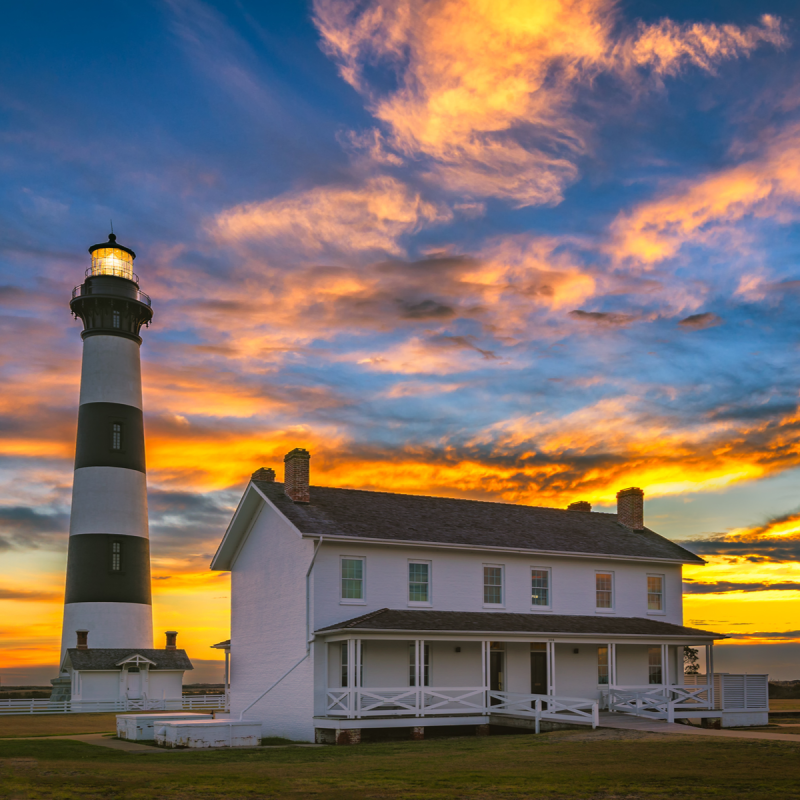
(Photo Credit: anthony heflin / Shutterstock.com)
Kitty Hawk is located on the Outer Banks of North Carolina. Crossing the Wright Memorial Bridge from mainland North Carolina via U.S. Highway 158 East, you’ll reach Kitty Hawk. The Outer Banks is a series of barrier islands that buffer mainland North Carolina from the Atlantic Ocean. At its narrowest, the sliver of land is a mere 150 feet wide. Kitty Hawk, located on Bodie Island, sits at one of the wider points — about 3 miles wide.
Videos by TravelAwaits
Years ago, Kitty Hawk proved to be ideal for the Wright Brothers’ first flight. The North Carolina “First in Flight” license plate logo reminds visitors of this. Kitty Hawk and Jockey Ridge State Park continue to be perfect for flight, time on the beach, and outdoor recreation.
Here are eight amazing things to do in gorgeous Kitty Hawk, North Carolina.
The Outer Banks Tourism Bureau hosted my visit. All opinions are my own.

(Photo Credit: Teresa Otto)
1. Welcome Center And The Monument To A Century Of Flight
While heading to the beach may be first and foremost on your list of things to do in Kitty Hawk, a trip to the Aycock Brown Welcome Center is well worth your time. You’ll be amazed at the attractions, historical sites, and recreational opportunities Kitty Hawk and the Outer Banks have to offer.
The Icarus Monument to a Century of Flight sits atop a hill adjacent to the visitor center. A wheelchair-accessible paved sidewalk leads from the parking lot to the monument. From here, you’ll get your first view of the ocean.
The monument begins with the first powered and controlled flight the Wright brothers accomplished just 6 miles away from the Icarus Monument in 1903. One hundred flight milestones are engraved on progressively larger free-standing granite stones that resemble tail sections of planes. The milestones include Amelia Earhart’s solo flight across the Atlantic in 1932, the role of the WASPs (Women Airforce Service Pilots), and the race to space against the Soviet Union in the 1950s and ‘60s. The final entry speaks to the cooperative environment of the International Space Station.
Over the course of 100 years, the advances in flight were meteoric.
Pro Tip
Along the Outer Banks, you’ll see directions that begin with a milepost number. The Aycock Brown Welcome Center and Century of Flight Monument can be found at Milepost 1.

(Photo Credit: Teresa Otto)
2. Kitty Hawk Beach
Kitty Hawk Beach runs the entire length of the town and is open to the public. Twelve beach access points between Mileposts 2 and 4.5 allow you to park and be on the beach in minutes. Sand dunes run the length of the Outer Banks, but those in Kitty Hawk aren’t quite as high as those farther south, making them more accessible.
The unspoiled beaches provide plenty of space and serenity. A local T-shirt I saw read, “saltwater heals everything.” It certainly seemed to be true. Whether you enjoy basking in the sun, surfing or watching surfers, flying a kite, or looking for seashells, you can easily lose track of time here.
And if you’re traveling with your dog, you are free to bring him on the beach, too. The city has a few requirements. Dogs need to be on a leash no longer than 6 feet during the day from Memorial Day to Labor Day. A longer leash — 12 feet — is okay the rest of the year. During the early morning and later in the evening, dogs don’t need to be leashed as long as you can maintain control. Details can be found here.
Pro Tip
The access points at Mileposts 2, 4, and 4.5 are wheelchair-accessible. For those staying in town, the Kitty Hawk Fire Department supplies beach wheelchairs and you can get on the sand on a first come, first served basis. Alternatively, you can rent a beach wheelchair from OBX Beach Mobility. Even without a beach wheelchair, you can enjoy a view of the beach and ocean from dune-top boardwalks and observation platforms.

(Photo Credit: Teresa Otto)
3. Wright Brothers National Memorial
The Wright Brothers National Memorial celebrates the first powered and piloted flight in the world. A tour of the grounds begins at the visitor center. The exhibits explore the Wright family, Orville and Wilbur’s early interest in flight, and their decision to fly at Kitty Hawk. The brothers needed a place that had steady winds, high sand dunes for take-off, a soft place to land, and privacy.
Wilbur Wright wrote to Kitty Hawk’s postmaster, Bill Tate, in 1900 asking about the town’s conditions. Tate let the Wrights know the conditions for testing their “machine” were ideal and he’d help them in any way he could.
Along with the visitor center and a replica of their plane, four large boulders mark the progressively longer flights. The historic flights occurred on December 17, 1903. Wilbur piloted the fourth and final flight that day. It lasted 59 seconds and traveled 852 feet.
On the memorial grounds, a large monument shaped like a plane’s tail section sits on the highest hill in the area. The monument overlooks the landing zone. Below, the First Flight Centennial Memorial — with life-sized sculptures of Wilbur Wright running alongside the 1903 Flyer, Orville as its pilot, the photographer, and four witnesses — brings the scene to life.
Pro Tips
The memorial is wheelchair-accessible. There’s parking at the visitor center, just below the hilltop memorial, and near the sculptures. Allow 2–3 hours for your visit.
The actual location where the Wright brothers made their flyer is on Postmaster Tate’s former property. The shed is gone but the Wright Brother’s Garage Monument erected in 1928 on the property shows where the Wright brothers built their plane.
4. Kitty Hawk Woods Reserve
If you’re looking to spend some time in a maritime forest, head to Kitty Hawk Woods Reserve. It’s one of five maritime forests on the East Coast. You’ll enjoy the shade of oak and maple trees while strolling along easy paths. You can also kayak through 8.5 miles of canals in the park.
Many year-round and migratory birds, including warblers, owls, woodpeckers, osprey, and bald eagles, call the reserve home. Deer, foxes, otters, turtles, orchids, and seven endangered plant species live here, too. Here are more details on what you can see and how to access the trail system.
Pro Tip
Use bug spray and protect yourself from ticks by wearing long-sleeved shirts and long pants while you’re there. The reserve is dog-friendly, provided your pup stays on a leash.

(Photo Credit: Teresa Otto)
5. Fishing
You certainly have choices when it comes to fishing. The Albemarle Sound on the western side of Kitty Hawk is home to flounder, striped bass, and redfish. Fishing from a boat, kayak, or pier works best according to local fishermen.
Charter boat, surf, and pier fishing are also popular on the Atlantic side. Grouper, blue marlin, snapper, flounder, and bluefin and yellowfin tuna take turns biting depending on the time of year. If you charter a fishing boat or fish from an ocean pier, you won’t need to buy a fishing license as it is covered with a blanket license.
Pro Tip
Nags Head, Avalon, and Jennette Fishing Piers sell bait and tackle and rent rods and reels.

(Photo Credit: Teresa Otto)
6. Jockey Ridge State Park — Kite Flying
In keeping up with North Carolina’s flight theme, if you’ve never flown a kite or would like to brush up on your skills, you can take a kite-flying lesson at Jockey Ridge State Park. Located at Milepost 12, the park is in the neighboring town of Kill Devil Hills.
After a kite-flying class and building your own box kite, head to the park’s 80-to-100-foot dune. You’ll learn to launch, steer, do stunts, and land your kite over the course of 1.5–2 hours.
Pro Tip
If you’re visiting in September, the Outer Banks Kite Festival brings some of the best stunt kite pilots together for demonstrations and synchronized flights of their massive novelty kites.

(Photo Credit: Robin O’Neal Smith)
7. Hang Gliding
Also in Jockey Ridge State Park, you can learn to hang glide. Kitty Hawk Kites teaches beginner’s hang-gliding lessons starting at ground school. Class continues on top of the sand dune with instructors coaching and holding onto the glider’s tethers.
Safety is their utmost concern so along with safety gear, your flights may be postponed for winds that are too strong or gusting.
Pro Tip
Kitty Hawk Kites accommodates those with mobility issues by offering tandem flights. They also teach hang gliding to those with vision and hearing impairment.

(Photo Credit: Teresa Otto)
8. TRiO Restaurant
Now that you’ve worked up an appetite, it’s time to try some local favorites at TRiO Restaurant and Market, Milepost 4.5. If you’re in the mood for sea-to-fork fare, try the jumbo lump crab cake sandwich or smoky garlic shrimp. You’ll find seafood, steak, chicken, and vegetarian options on the menu. The staff is happy to recommend wine flights or draft beer from their extensive selection.
TRIO’s market has a great selection of wine, beer, cheese, gifts, and souvenirs.
Read about these amazing coastal North Carolina destinations:
